

Vol. 38 (Nº 51) Year 2017. Page 8
Anastasiia VASILIIEVA 1; Svetlana KOPTYAKOVA 2; Maria PAVLUHINA 3; Irina AKULOVA 4; Galina KHAKOVA 5; Tatiiana SALIAIIEVA 6
Received: 05/10/2017 • Approved: 18/10/2017
ABSTRACT: The purpose of this article is to develop and substantiate a comprehensive methodological approach to performance evaluation of fiscal sharing between budgets of different level as a direction for improving the financial stability of single-industry cities in the Russian Federation. The research of the claimed problem is based on a complex of statistical analysis methods, which includes the correlation method and the average values method. Using correlation analysis tools, the relationship, its nature and direction between the federal, regional, local taxes revenues volume and taxes paid in connection with the application of special tax regimes, and the integrated index values of single-industry town budget solvency. The average values method is used to calculate the optimal values of the tax revenues deduction norms, under which the maximum integral index increase characterizing the subnational entities financial stability is observed, as well as the economical balance of all administration levels and tax payers. The article reflects the results of the development and justification of a fundamentally new integrated methodological approach to performance evaluation of the current system of fiscal sharing between the budgets of different levels by comparing the criteria proposed by the authors for the “budget tax revenues” and the “financial stability integral index”, and presents its systematic mathematical algorithm. |
RESUMEN: El propósito de este artículo es desarrollar y fundamentar un enfoque metodológico integral para la evaluación del desempeño y distribución fiscal entre los presupuestos de diferentes niveles como una política para mejorar la estabilidad financiera de las ciudades de industria única en la Federación Rusa. La investigación del problema reseñado se basa en un complejo de métodos de análisis estadístico, que incluye el método de correlación y el método de valores promedio. Utilizando herramientas de análisis de correlación, la relación, su naturaleza y dirección entre el volumen de ingresos por impuestos federales, regionales y locales e impuestos pagados en relación con la aplicación de regímenes fiscales especiales, y los valores de índice integrados de la solvencia presupuestaria de una sola industria. El método de valores promedio se utiliza para calcular los valores óptimos de las normas de deducción de ingresos tributarios, bajo los cuales se observa el máximo índice integral que caracteriza a las entidades subnacionales, la estabilidad financiera, así como el equilibrio económico de todos los niveles de administración y contribuyentes. El artículo refleja los resultados del desarrollo y la justificación de un enfoque metodológico integrado fundamentalmente nuevo para la evaluación del desempeño del sistema actual de distribución fiscal entre los presupuestos de diferentes niveles al comparar los criterios propuestos por los autores para los "ingresos fiscales" y el "índice integral de estabilidad financiera", y presenta su algoritmo matemático sistemático. |
Modern economic situation demonstrates a severe asymmetry in the financial evolution of multi- and single-industry subnational entities of the Russian Federation, which is due to the chronic shortage of own resources to cover budget expenditure items of the latter. The level equalizing state-used horizontal and vertical instruments of territories' financial capacities oriented toward income producing powers distribution between the Russian Federation, the subjects of the Russian Federation and municipalities, lead to a high level of revenues centralization in the federal budget and, accordingly, to negative consequences. The negative consequences of the national budgetary practice are resource dependence on the higher level, a decrease in the interest of single-industry town authorities to expand own income base, as well as the temptation to increase the expenditures amount and local budgets deficit. It should be noted that “many fiscally decentralized economies rely heavily on transfers from upper to lower-level governments as well as on equalizing transfers between lower-level governments” (Lundqvist, 2015).
Achieving the financial stability for a single-industry town requires, first of all, development and implementation of incentive mechanisms to encourage modern territories to make efforts for increasing the total resource base, forming and strengthening their tax potential (Uvarova, 2013; Golovina, 2013). Doubtlessly, the stated problem is realized and discussed at different governmental levels. However, in the author's opinion, the problem cannot be resolved at a qualitative level without a comprehensive study of the performance evaluation of the current system of fiscal sharing between the budgets of different levels as areas for improving the Russian single-industry town financial stability, and also without cooperation with the scientific community (Balynskaya, 2013). The current mechanism for inter-budget relations evaluation does not reflect the real resource availability of the territory and distorts the rating of its social and economic dynamics (Zenchenko, 2009).
Moreover, in the course of analyzing the researched problem development degree, it was revealed that there are practically no publications on the development of approaches to performance evaluation of inter-budget equalization systems of Russian single-industry town financial capacity and publicizing their approbation results. Most of the works are based on an analysis of certain criteria for the distribution quality of subnational entities income producing powers and do not affect the issues of conducting a consolidated assessment. These works include the papers by I.A. Avetisyan (2011), R. Bahl and J. Linn (1986, 1994), R.V. Badylevich and E.A. Verbinenko (2013), R. Boadway, K. Cuff and M. Marchand (2003), A. Chernyavsky and K. Vartapetov (2004), W. Jack (2005), A.G. Vasiliieva et al. (2017), S.V. Zenchenko (2009), A.V. Kizeev (2011), P. Liberati and А. Sacchi (2013), H. Lundqvist (2015), I. Marques, E. Nazrullaeva and A. Yakovlev (2016), L.R. Mello (1999, 2000), P.B. Nortman (1971), M.A. Pechenskaya and T.V. Uskova (2012), E.B. Staats (1974) and others.
The above-mentioned circumstances determined the relevance and practical importance of the scientific research, within the framework of which, a comprehensive methodological approach to the performance evaluation of the current system of fiscal sharing between the budgets of different levels as areas for improving the Russian single-industry towns financial stability was substantiated. The research was made in a large industrial center and a single-industry town in the Chelyabinsk Region – Magnitogorsk, which arose on the wave of epoch-making social transformations as a settlement at a metallurgical plant (Turgel and Vlasova, 2016).
The proposed consolidated methodology for the economic and statistical performance evaluation of the current system of fiscal sharing between the budgets of different levels as areas for improving the Russian single-industry town financial stability is based on the following stages:
In the first stage, a statistical study reveals and analyzes the relationship between the tax revenues volume for federal, regional, local taxes, as well as taxes paid in connection with the application of special tax regimes, and the Russian single-industry town budget financial stability integral index values. Note that it is in the process of statistical investigation of dependencies that causal relationships between phenomena are revealed - “the connection of phenomena and processes, when a change in one of them - causes - leads to a change in the other - the effect” (Vasiliieva, 2011).
It is proposed to highlight the factor attributes and the performance indicators necessary for the study to identify the existence of the relationship, its nature and direction between federal, regional and local tax revenues, as well as special tax regimes in the territorial formation budget, and the financial stability integral measure. The authors recommend accepting the revenues amounts for federal, regional and local taxes, as well as for special tax regimes in the local budget as an analysis factor, and a single-industry town financial stability integral indicator as an effective indicator.
The relationship tightness is quantitatively expressed by the correlation coefficients magnitude, including the correlation relationship tightness between tax revenues and the integral index of single-industry town financial stability can be measured by the determination coefficient . The determination coefficient is the indicator representing an inter-group dispersion share relative value in the overall effective indicator variance and reflecting the strength of the factor sign influence on the effective indicator overall variation formation (Vasiliieva, 2011):

Table 1. Cheddock ratio
|
0.1-0.3 |
0.3-0.5 |
0.5-0.7 |
0.7-0.9 |
0.9-0.99 |
Relationship tightness |
Weak |
Average |
Noticeable |
Close |
Rather close |
The second stage offers to calculate the tax revenues normative deduction optimal values under which the maximum subnational entity financial stability integral indicator increase is observed, and also the balance of economic interests of all government and taxpayers levels is maintained with the help of the arithmetic mean weighted:

Calculation of the optimal values of normative deductions of Russian single-industry town budget tax revenues is recommended to be complemented by the identification of similar values at the current date and their comparison.
The article attempts to assess the feasibility of the practical application of the performance evaluation integrated approach of financial capacities level equalizing state-used instruments on the example of a large industrial center and a single-industry town in the Chelyabinsk Region of the Russian Federation – Magnitogorsk. In this regard, N.A. Kharitonova, E.N. Kharitonova and N.L. Levinson note the following: “Economic restructuring within the Russian Federation has considerably reduced the number of industrial giants, many of which proved unviable in the new economic conditions. However, those that remain are leaders in Russian industry, and their success determines the life not only of the local municipalities but often also of the whole region where they are located; as before, they continue to determine the economic and industrial potential of the region” (Kharitonova et al., 2007).
The rationality of selecting the research place is determined not only by the subnational entity single-industry nature, but also by the high resource dependence of the Magnitogorsk budget identified by the authors from a higher level, and by the gradual decrease in the municipal authorities interest to expand own income basis. In particular, in 2012 the single-industry town budget tax revenues were almost equivalent to inter-budget transfers - 42.08% versus 50.18%, whereas in 2016 the gap between tax revenues and inter-budget transfers significantly increases - 25.90% versus 66, 09%, which is graphically represented in Figure 1 (Turgel et al., 2016).
Figure 1. Single-industry town budget
revenues structure in 2012-2016, in percent

The results of the first stage, which involves the identification of the relationship between federal, regional and local taxes, as well as special tax regimes to the single-industry town budget and the financial stability integral index using the determination coefficient, are presented in Table 2 and Figures 2-5.
Table 2. Relationship degree of tax revenues and financial
stability integral index of a single-industry town budget
Factor, X |
Result, Y |
Relationship existence |
|
|
Relationship |
||
Revenue amount in budgets under federal taxes |
Budget financial stability integral indicator |
0.8538 |
Close |
Revenue amount in budgets under regional taxes |
0.8712 |
Close |
|
Revenue amount in budgets under local taxes |
0.9898 |
Rather close |
|
Revenue amount in budgets under special tax regimes |
0.9799 |
Rather close |
|
-----
Figure 2. Dependence between federal tax revenues and the
financial stability integral index of a single-industry town budget
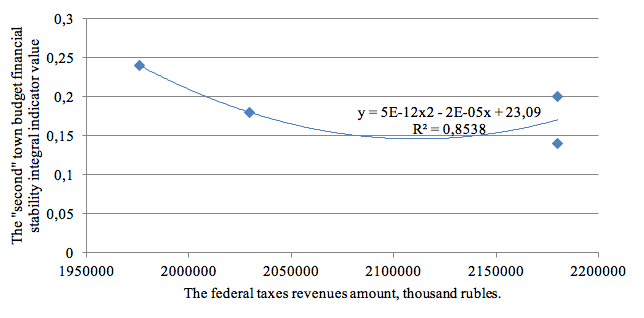
-----
Figure 3. Dependence between regional tax revenues and the
financial stability integral index of a single-industry town budget
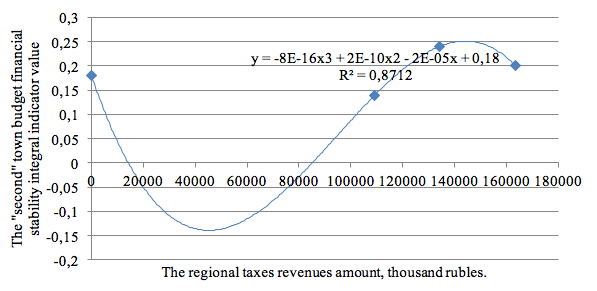
-----
Figure 4. Dependence between local tax revenues and the
financial stability integral index of a single-industry town budget
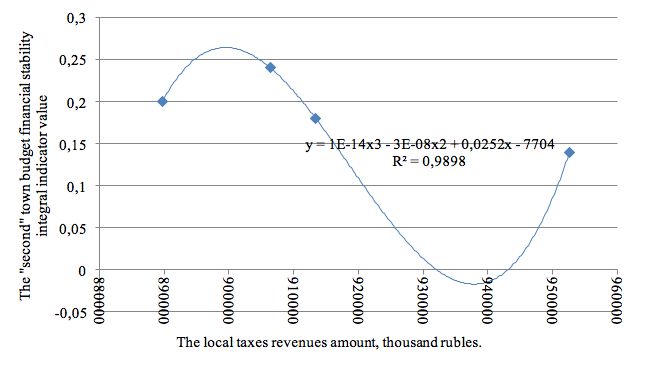
Figure 5. Dependence between special tax regimes revenues and
the financial stability integral index of a single-industry town budget
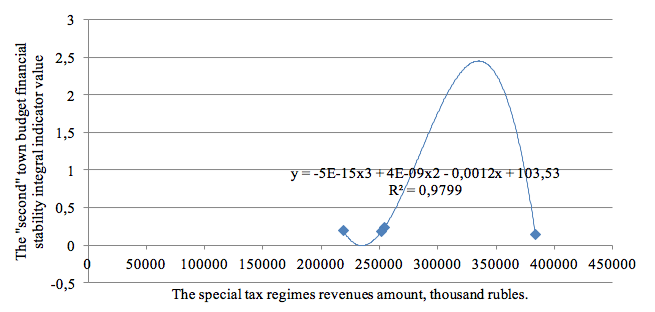
Since the determination coefficient shows the Y resultant sign variation share under the X sign factor influence, the determination coefficient calculated values analysis indicates a close functional relationship between the tax revenues level in the local budget and the Magnitogorsk budget financial stability integral indicator. In particular: local budget financial stability integral index variation by 85.38% is due to a change in the federal taxes revenues level and other factors by 14.62%; local budget financial stability integral index variation by 87.12% is due to a change in the regional taxes revenues level and other factors by 12.88%; local budget financial stability integral index variation by 98.98% is due to a change in the local taxes revenues level and other factors by 1.02%; local budget financial stability integral index variation by 97.99% is due to a change in the special tax regimes revenues level and other factors by 2.01%.
The final results of the second stage, which involves the tax revenues normative deduction optimal values identification, under which the maximum increase in the integral index of single-industry town financial stability is observed, using the arithmetic mean weighted, are presented in Table 3.
Table 3. Degree of compliance of the normative tax revenues deductions
to the single-industry town budget with the financial stability requirements
Result, Y |
Factor, X |
Optimum level of tax deductions to the town budget,% |
Budget financial stability integral indicator |
Normative deductions to budgets under federal taxes |
|
Personal income tax |
30.0 |
|
State duty |
100.0 |
|
Normative deductions to budgets under regional taxes |
||
Transportation tax |
50.0 |
|
Gambling tax |
40.0 |
|
Normative deductions to budgets under local taxes |
||
Land tax |
100.0 |
|
Personal income tax |
100.0 |
|
Normative deductions to budgets under special tax regimes |
||
Uniform tax on imputed income for certain activities |
100.0 |
|
Unified agricultural tax |
100.0 |
|
The tax levied with the taxation patent system application |
100.0 |
|
The calculation results show that the optimal tax revenues deductions amount to Magnitogorsk's budget, which stimulates subnational entity financial stability, is at the level of the year of 2013 and significantly differs from the normative values provided for by the Budget Code of the Russian Federation (1998), which is systematized in Table 4.
Table 4. Normative deductions to local
budgets established by the budget legislation
Taxes and fees established by the legislation of the Russian Federation |
Normative deductions to the town budget, % |
|
2013 |
2016 |
|
Federal taxes and fees |
||
Personal income tax |
30.0 |
15.0 |
State duty |
100.0 |
100.0 |
Excises on automobile and straight-run gasoline, diesel fuel, motor oils for diesel and (or) carburetor (injector) engines produced in the territory of the Russian Federation |
- |
10.0 |
Regional taxes and fees |
||
Transportation tax |
50.0 |
- |
Gambling tax |
40.0 |
- |
Local taxes |
||
Land tax |
100.0 |
100.0 |
Personal income tax |
100.0 |
100.0 |
Special tax regimes |
||
Uniform tax on imputed income for certain activities |
100.0 |
100.0 |
Unified agricultural tax |
100.0 |
100.0 |
The tax levied with the taxation patent system application |
100.0 |
100.0 |
Moreover, the calculation results are confirmed by the maximum values of the integral indicator of single-industry town budget financial stability and town's growth rate achieved in 2013, which is graphically reflected in Figure 6.
Figure 6. Dynamics of the values and growth rates of the single-industry town budget financial stability integral indicator in 2012-2016
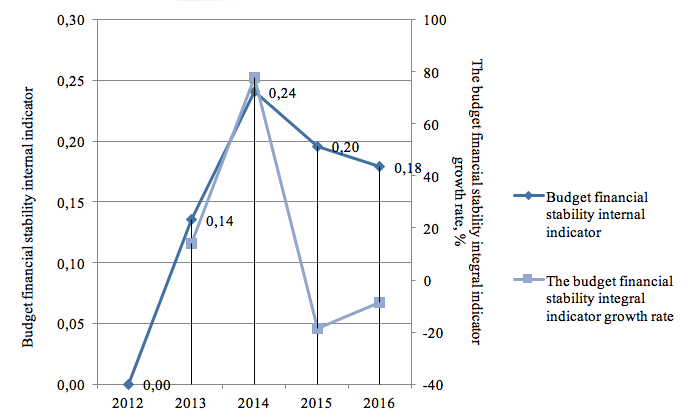
The authors made the following principal result in the process of achieving the stated purpose of the study, which consisted in improving the existing methodological approaches to performance evaluation of the current fiscal sharing system applicable for different level budgets as a direction for improving the financial stability of company towns in the Russian Federation.
Following the results of comparative analysis of the diversity of approaches to performance evaluation of inter-budget equalization systems of Russian single-industry town financial capacity, it was revealed that to date, the majority of the works is based on analyzing certain quality criteria for subnational entities income producing powers distribution, also the publications on the complex research methods are also virtually not present. The authors of the article attempted to eliminate the indicated gap in modern financial science by developing and substantiating a comprehensive methodological approach to Russian current inter-budget relations system performance evaluation.
The proposed consolidated methodology for the economic and statistical evaluation of the current system of fiscal sharing between the budgets of different levels as areas for improving the Russian single-industry town financial stability is based on the following stages:
- Statistical study of the existence of a link, its nature and direction between the tax revenues volume for federal, regional, local taxes, as well as taxes paid in connection with the special tax regimes applications, and the Russian integral index of single-industry town financial stability values by finding the factor and performance indicators and calculating the correlation coefficient;
- Calculation of the optimal values of the tax revenues deduction norms, under which the maximum integral index increase characterizing the subnational entities financial stability is observed, as well as the economical balance of all administration levels and tax payers.
- Performance evaluation of Russian single-industry town inter-budget relations by identifying values of the deduction norms of single-industry town tax revenues at the current date and their comparison with the optimal values.
Approbation of the proposed criteria and the presented approach to the evaluation of the effectiveness of the performance evaluation of the current fiscal sharing system applicable for different level budgets, accounting for the “budget fiscal revenues” and the “financial stability integral index”, confirmed the significance of the achieved results. The proposed method for performance evaluation of the current fiscal sharing system applicable for different level budgets will allow for regular monitoring the compliance of territorial fiscal policy performance actual indicators with optimal values, increase the municipal authorities interest in reducing resource dependence from a higher level.
Avetisyan, I.A. (2011). Fiscal federalism and inter-budget relations in the Russian Federation. Economic and Social Changes: Facts, Trends, Forecast, 1(13), 95-108.
Bahl, R. (1986). The design of intergovernmental transfers in industrialized countries. Public Budgeting & Finance, 4, 3-22.
Bahl, R., & Linn, J. (1994). Fiscal decentralization and intergovernmental transfers in less developed countries. The Journal of Federalism, 1, 1-19.
Balynskaya, N.R. (2013). Subjects information and political governance in Russia at the present stage. Economics and politics, 1 (1), 144-146.
Boadway, R., Cuff, K., & Marchand, M. (2003). Equalization and the decentralization of revenue-raising in a federation. Journal of Public Economic Theory, 2, 201-228.
Chernyavsky, A., & Vartapetov, K. (2004). Municipal finance reform and local self-governance in Russia. Post-Communist Economies, 3, 251-264.
Golovina, T.A. (2013). Concept application “management future” for forecasting of financial results industrial enterprises. Contemporary Economic Issues, 1. DOI: 10.24194/11304 . URL: http://economic-journal.net/index.php/CEI/article/view/32/20
Jack, W. (2005). Comparing the distortionary effects of alternative intergovernmental transfers. Public Finance Review, 4, 488-505.
Kharitonova, N.A., Kharitonova, E.N., & Levinson, N.L. (2007). Simulation of Social Costs and Corresponding Sources of Financing in City (Regional) Budgets. Steel in Translation, 3, 248-251.
Kizeev, A.V. (2011). Financial potential as a criterion for assessing the financial independence of the region. Economic research, 5, 4.
Liberati, P, ·& Sacchi, A. (2013). Tax decentralization and local government size. Public Choice, 157, 183-205.
Lundqvist, Н. (2015). Granting public or private consumption? Effects of grants on local public spending and income taxes. International Tax and Public Finance, 22 (1), 41-72.
Marques, I., Nazrullaeva, E., & Yakovlev, A. (2016). Substituting distribution for growth: the political logic of intergovernmental transfers in the Russian Federation. Economics & Politics, 1, 23-54.
Mello, L.R. (1999). Intergovernmental fiscal relations: coordination failures and fiscal outcomes. Public Budgeting & Finance, 1, 3-25.
Mello, L.R. (2000). Fiscal decentralization and intergovernmental fiscal relations: a cross-country analysis. World Development, 2, 365-380.
Nortman, P.B. (1971). State and local tax reform. Urban Affairs Review, 1, 41-60.
Pechenskaya, M.A., & Uskova, T.V. (2012). Topical issues of the improvement of intergovernmental dealings in the system of local government. Economic and Social Changes: Facts, Trends, Forecast, 1 (19), 115-124.
Staats, E.B. (1974). Intergovernmental relations: a fiscal perspective. Annals of the American Academy of Political and Social Science, 1, 32-39.
The Budget Code of the Russian Federation of 31.07.1998 no. 145-FZ. 1998. URL: http://www.consultant.ru/document/cons_doc_LAW_19702/
Turgel, I.D., Bochco, L.L., & Linshui, X. (2016). Government support of single-industry towns in Russia and Kazakhstan. Financial University Bulletin, 2, 22-32.
Turgel, I.D., & Vlasova, N.Yu. (2016). The second Urals cities: from the city-pant to the multifunctional centers. Regional Research, 2 (52), 43-54.
Uvarova, I.I. (2013). Legal regulation of the budgetary account and the budgetary reporting in the Russian Federation. Contemporary Economic Issues, 3. DOI: 10.24194/31302 . URL: http://economic-journal.net/index.php/CEI/article/view/66/54
Vasiliieva, A.G. (2011). Evaluation of performance fiscal regulation of innovation development of economy. The economic analysis: theory and practice, 15, 36-42.
Vasiliieva, A.G., Gafurova, V.M., Kashuba, I.V., Kiva-Khamzina, Y.L., Nazarova, O.L., & Orinina, L.V. (2017). Complex methodical approach to assessing the effectiveness of managing the financial capability of the Russian Federation subjects. Journal of Applied Economic Sciences, Volume XII, 2 (48), 636-645.
Verbinenko, E.A., & Badylevich, R.V. (2013). Methodological approaches to the content and assessment of the region financial capacity. Bulletin ENGECON, 2 (61), 60-67.
Zenchenko, S.V. (2009). Formation and assessment of regional financial potential of sustainable development areas of the economy: the theory and methodology (Candidate thesis, North Caucasus State Technical University, Russia).
1. State and Municipal Management and Human Capital Management Department, State Federal-Funded Educational Institution of Higher Professional Training “Nosov Magnitogorsk State Technical University”, Candidate of Sciences (Economics), Assistant Professor, Magnitogorsk, Russia, agvasileva@inbox.ru
2. State and Municipal Management and Human Capital Management Department, State Federal-Funded Educational Institution of Higher Professional Training “Nosov Magnitogorsk State Technical University”, Candidate of Sciences (Pedagogy), Assistant Professor, Magnitogorsk, Russia, svetlana.cop@yandex.ru
3. State and Municipal Management and Human Capital Management Department, State Federal-Funded Educational Institution of Higher Professional Training “Nosov Magnitogorsk State Technical University”, Senior Lecturer, Magnitogorsk, Russia, aleksandrovamaria92@mail.ru
4. Philosophy Department, State Federal-Funded Educational Institution of Higher Professional Training “Nosov Magnitogorsk State Technical University”, Candidate of Sciences (Philosophy), Associate Professor, Magnitogorsk, Russia, akulova_i@list.ru
5. Philosophy Department, State Federal-Funded Educational Institution of Higher Professional Training “Nosov Magnitogorsk State Technical University”, Candidate of Sciences (Philosophy), Associate Professor, Magnitogorsk, Russia, balyn@list.ru
6. Design Department, State Federal-Funded Educational Institution of Higher Professional Training “Nosov Magnitogorsk State Technical University”, Candidate of Sciences (Pedagogy), Associate Professor, Magnitogorsk, Russia, salyeva@yandex.ru